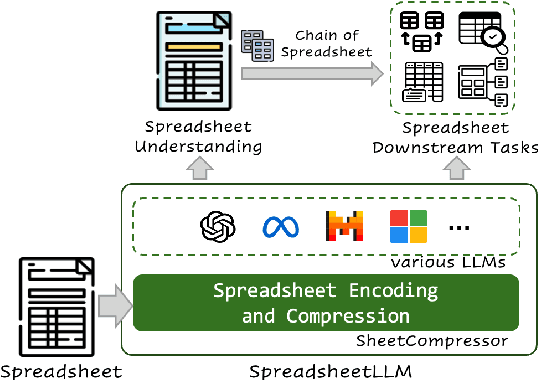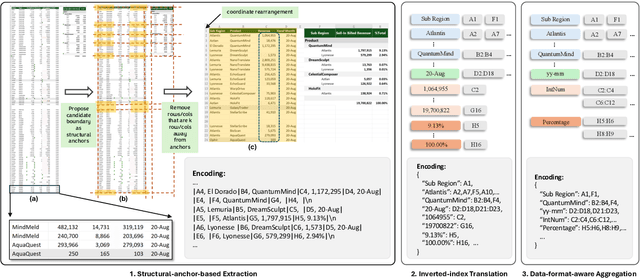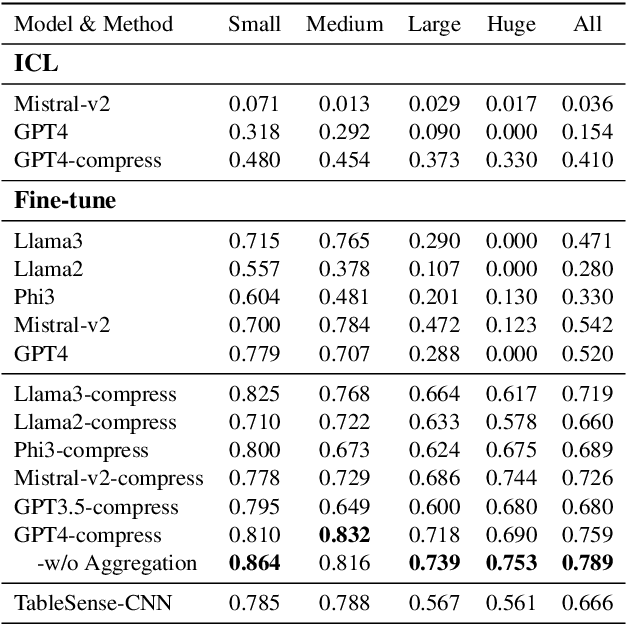Junyu Xiong
SpreadsheetLLM: Encoding Spreadsheets for Large Language Models
Jul 12, 2024



Abstract:Spreadsheets, with their extensive two-dimensional grids, various layouts, and diverse formatting options, present notable challenges for large language models (LLMs). In response, we introduce SpreadsheetLLM, pioneering an efficient encoding method designed to unleash and optimize LLMs' powerful understanding and reasoning capability on spreadsheets. Initially, we propose a vanilla serialization approach that incorporates cell addresses, values, and formats. However, this approach was limited by LLMs' token constraints, making it impractical for most applications. To tackle this challenge, we develop SheetCompressor, an innovative encoding framework that compresses spreadsheets effectively for LLMs. It comprises three modules: structural-anchor-based compression, inverse index translation, and data-format-aware aggregation. It significantly improves performance in spreadsheet table detection task, outperforming the vanilla approach by 25.6% in GPT4's in-context learning setting. Moreover, fine-tuned LLM with SheetCompressor has an average compression ratio of 25 times, but achieves a state-of-the-art 78.9% F1 score, surpassing the best existing models by 12.3%. Finally, we propose Chain of Spreadsheet for downstream tasks of spreadsheet understanding and validate in a new and demanding spreadsheet QA task. We methodically leverage the inherent layout and structure of spreadsheets, demonstrating that SpreadsheetLLM is highly effective across a variety of spreadsheet tasks.
Vision Language Models for Spreadsheet Understanding: Challenges and Opportunities
May 25, 2024



Abstract:This paper explores capabilities of Vision Language Models on spreadsheet comprehension. We propose three self-supervised challenges with corresponding evaluation metrics to comprehensively evaluate VLMs on Optical Character Recognition (OCR), spatial perception, and visual format recognition. Additionally, we utilize the spreadsheet table detection task to assess the overall performance of VLMs by integrating these challenges. To probe VLMs more finely, we propose three spreadsheet-to-image settings: column width adjustment, style change, and address augmentation. We propose variants of prompts to address the above tasks in different settings. Notably, to leverage the strengths of VLMs in understanding text rather than two-dimensional positioning, we propose to decode cell values on the four boundaries of the table in spreadsheet boundary detection. Our findings reveal that VLMs demonstrate promising OCR capabilities but produce unsatisfactory results due to cell omission and misalignment, and they notably exhibit insufficient spatial and format recognition skills, motivating future work to enhance VLMs' spreadsheet data comprehension capabilities using our methods to generate extensive spreadsheet-image pairs in various settings.
 Add to Chrome
Add to Chrome Add to Firefox
Add to Firefox Add to Edge
Add to Edge